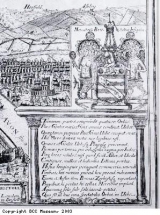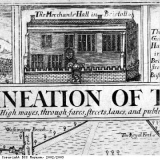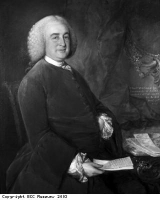The organisation of trade in Bristol
The Society of Merchant Venturers, which still exists today, began in 1552 as an elite body of Bristol merchants involved in overseas trade. As their name suggests, they were an organisation of merchants who saw themselves as venturers or entrepreneurs . Many of the Society of Merchant Venturers were also members of Bristol Corporation, the council that ran the city. They were powerful men. The setting up of the Society transformed a loose network of traders into a formal organisation to promote trade. The Society held meetings in the ‘Merchants Hall’ in King Street, Bristol. This hall, shown here in a drawing of 1673, was the Society’s head quarters for 450 years. In 1783 the Society rebuilt their Hall, transforming it into an elegant building in a modern style. It was destroyed by bombing during World War II. The Society then moved out of King Street to their present Hall in Clifton.
The members of the Society were the leading merchants of the city and they had asked King Edward VI for a charter (a licence) allowing them to oversee foreign trade. They complained that the city’s trade was being ruined by untrained merchants. The King’s charter gave control of overseas trade to the Society and the rules governing membership stated that members should have been through a proper apprenticeship or training in the ‘Arte of Merchaunts’ (the Art of the Merchant). It was the job of Members of Parliament such as Robert Nugent, pictured here, to protect the interests of Bristol’s merchants. He was Member of Parliament for Bristol from 1754 to 1774. This portrait was painted to mark Nugent’s re-election, in 1759. On the table beside him is a government Act, or law, for improving and extending the ‘African Trade’.
The arms, or symbol representing the Society of Merchant Venturers, picured here, show the Society’s connection with the sea. The shield has a background of blue waves and above it is a ship’s mast. One of the supporters, holding the shield, is a mermaid who is holding an anchor.





